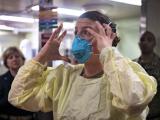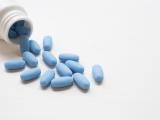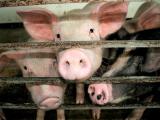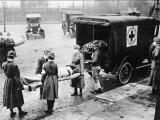Aug 8, 2011 (CIDRAP News) – Researchers who combed through scores of serologic studies estimate that the global cumulative incidence of pandemic H1N1 influenza infection before vaccines became available was probably below 20%, far lower than the 50% that pandemic planners had envisioned as a possible worst case.
They came up with an overall estimate of 11% to 21%, according to their report in PLoS One. But in line with previous studies, the incidence differed widely by age-group, ranging from 34% to 43% in school-age children and dropping to only about 3% in older adults.
The researchers, from Australia, Hong Kong, and Japan, say the light burden of infection in elderly people—probably due to previous exposures to relatives of the pandemic virus—largely explains the "lower than anticipated" overall incidence of infection.
The research team searched for serologic surveys on H1N1 infection that were published between April 2009 (the start of the pandemic) and December 2010, looking for surveys that included samples taken before the pandemic and after the first wave but before vaccines became widely available in late 2009.
They found just 12 studies from eight countries that met their criteria. Most of the serum samples used in the studies were left over from miscellaneous diagnostic tests. The studies ranged in size from 15,000 samples in a Hong Kong study to 600 in a Canadian one.
For school-age children, 5 to 19 years old, the incidence rates ranged from 34% to 43%, though there was some inconsistency for subgroups within that range. Where age-groups were separated, a Hong Kong study found higher rates in primary school children (5 to 12 years), while studies in Australia and India showed a higher rate in older children.
For preschool children (0 to 4 years) the incidence was 16% to 28%, on the basis of the limited number of studies that included that age-group. On the other end of the age spectrum, the incidence in those older than 65 years was only 2% to 3%. And for non-elderly adults, the numbers varied, generally decreasing with increasing age.
Only three studies included all age-groups. The estimated incidences included 10.7% in Hong Kong, 15.6% in New South Wales, Australia, and 18.3% in Hong Kong.
However, the authors re-estimated the overall incidence to allow for infections that might not have been detected by serology, and this yielded an overall incidence of 11% to 21% (instead of 11% to 18%).
They note that in a study in Hong Kong, 10% of 881 patients with pandemic H1N1 infections confirmed by polymerase chain reaction had a neutralizing antibody titer below 40, the conventional cutoff for defining seroprotection. Also, antiviral treatment was associated with low convalescent antibody titers, potentially affecting serologic study results in some countries.
"This review confirms that cumulative incidence of infection during the first and second [pandemic] waves prior to the availability of a pandemic specific vaccine anywhere in the world, fell well below the assumption of an upper estimate of a 50% clinical attack rate that had informed the pandemic planning of the United Kingdom and other countries," the report says.
"The lower than anticipated cumulative incidence was likely due to the significant number of older people protected by neutralising antibodies that cross-reacted with pH1N1," it adds. The findings also confirm that school-age children had the highest rate of infection.
The authors comment that using leftover diagnostic serum samples is less than ideal because of potential biases related to the risk of infection and to vaccination history in hospital patients, from whom most of the samples come. But they say serum samples from healthy blood donors yielded similar estimates of the incidence of infection.
"Serological studies need to be routine in order to be sufficiently timely to provide support for decisions about [pandemic] vaccination, and revised pandemic plans might consider a more integrated role for serological studies," the researchers conclude.
Kelly H, Peck HA, Laurie KL, et al. The age-specific cumulative incidence of infection with pandemic influenza H1N1 2009 was similar in various countries prior to vaccination. PLoS One 2011 Aug 5;6(8) [Full text]
See also:
Dec 10, 2009, CIDRAP News story "CDC sharply raises H1N1 case estimates; kids hit hard"




















